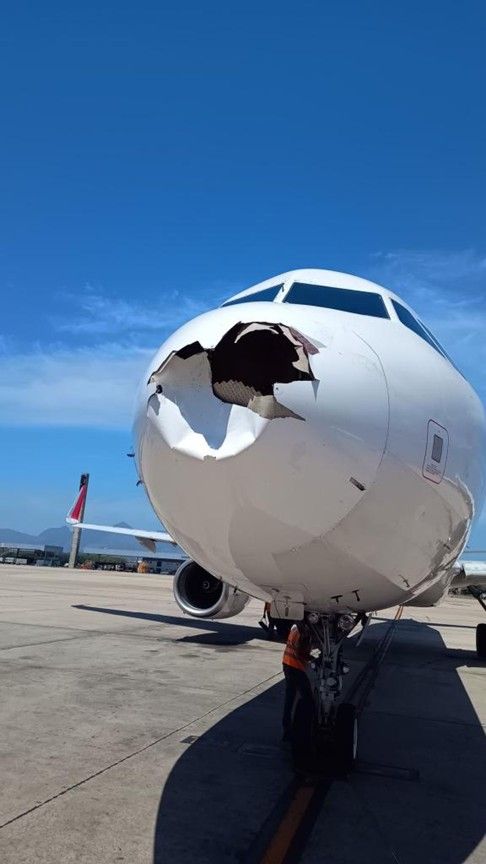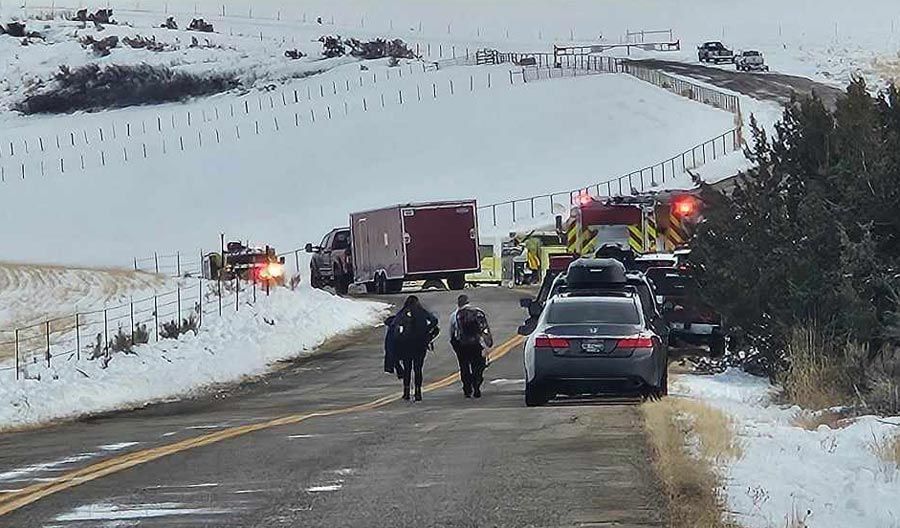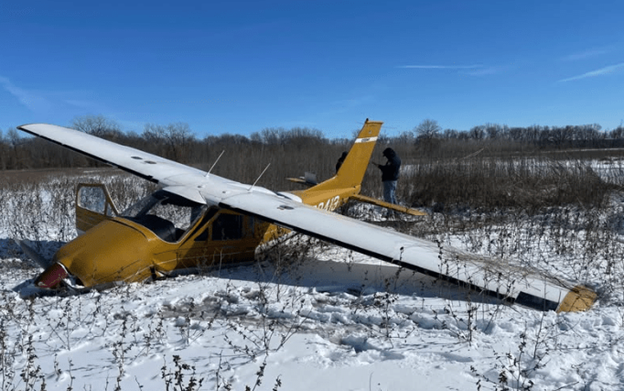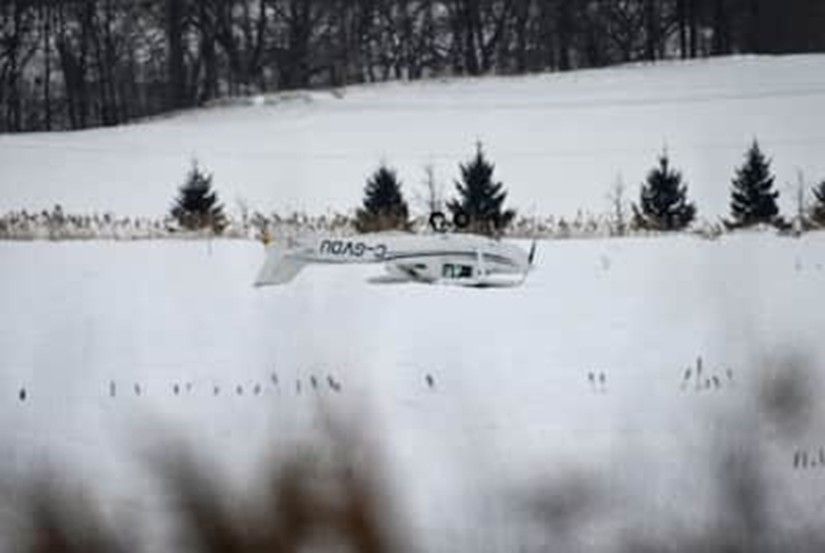ARFF Daily News
Published on:
Friday the 21st of February, 2025
Plane’s nose smashed in, smeared in blood from bird strike just moments after takeoff
By Zoe Hussain
Startling images show an airplane’s nose completely smashed in and smeared in blood from a bird strike.
Latam flight LA3367 had just taken off from Rio de Janeiro heading to São Paulo in Brazil on Thursday when it was struck by birds, forcing it to turn around for an emergency landing, Agencia Brasil reported.
Photos show the Airbus jet’s nose smashed in — with a large hole — and blood smeared around another dent.
Nobody was injured, but the flight was ultimately canceled — angering LATAM’s CEO, Jerome Cadier.
“I’m venting!” the CEO wrote in a frustrated LinkedIn post about the incident.
“Another bird strike occurred. The plane returned safely, but the flight was obviously canceled, disrupting the lives of all the passengers, and of course the airline as well,” the executive wrote.
The incident occurred just days after a Latam flight 3319 from Fortaleza Airport to Guarulhos International Airport in São Paulo was struck by birds just minutes after taking off Monday, Diario de Nordeste reported.
That flight was similarly forced to make an emergency landing back at Fortaleza airport, the outlet said.
https://nypost.com/2025/02/21/world-news/planes-nose-smashed-in-and-smeared-in-blood-from-bird-strike-just-after-takeoff/

1 dead, 1 injured after helicopter crashes into Ririe Reservoir
Nate Eaton, EastIdahoNews.com
BONNEVILLE COUNTY — One person is dead and another was rushed to the hospital after a helicopter crashed on the ice at Ririe Reservoir Thursday afternoon.
The crash happened around 4:40 p.m. about a mile east of the Ririe Dam, according to a news release from the Bonneville County Sheriff’s Office.
Emergency crews rushed to the scene and deployed on snow machines from the Juniper Campground area. Two occupants were found inside the helicopter. One was dead and the other was taken to an ambulance before being transported to the hospital with non-life threatening injuries, the sheriff’s office says.
A downed power line was discovered in the area of the crash.
“Deputies have closed Ririe Reservoir and the area around the crash site for safety due to downed power lines and unstable ice conditions,” the news release says. “The circumstances of why the helicopter was in that area are still being confirmed and the investigation is continuing.”
Multiple agencies responded to the scene, including Idaho Falls Fire, Jefferson Central Fire, Jefferson County Sheriff’s Office, Idaho Fish and Game, Bonneville County Sheriff’s Office Search and Rescue, Bonneville County Fire Ammon Division, Bonneville County Coroner’s Office, Dive Rescue and Drone Teams.
The names of those involved have not been released. The FAA and NTSB are investigating the crash.
https://www.eastidahonews.com/2025/02/1-dead-1-injured-after-helicopter-crashes-into-ririe-reservoir-ice/

Frozen fuel line blamed in Linn County plane crash
by: Barry Owens
LINN COUNTY, Kan. (KSNW) – A pilot safely crash-landed in a marsh in Linn County on Thursday, blaming a frozen fuel line for the emergency stop.
The Kansas Highway Patrol responded to the plane crash just after noon at a field near the intersection of County Road 1650 and County Road 1095.
The aircraft, a 1968 Cessna 177A, originated from South Dakota. The 42-year-old pilot from Indianapolis was not injured in the crash.
https://www.ksn.com/news/state-regional/no-injuries-in-plane-crash-in-linn-county-field/

Cessna plane crashes on the edge of Highway 30
Maxime Deland
A small plane crashed in a field along Highway 30 late Thursday afternoon, in the Saint-Bruno-de-Montarville area. Miraculously, the two occupants did not suffer any scratches.
Emergency services spotted the Cessna upside down in a field between Highway 30 and Mont Saint-Bruno. However, the damage to the aircraft appeared to be relatively minor under the circumstances.
According to our information, the aircraft suffered an engine failure in mid-flight, forcing the pilot to attempt an emergency landing.
Two people were on board the aircraft. They were reportedly rescued and transported to a safe place.
Miraculously, they were not injured.
https://www.journaldequebec.com/2025/02/20/un-avion-cessna-secrase-en-bordure-de-lautoroute-30

NTSB Final Report: Gyro Technic GT-VX2
A Witness On The Ground Observed The Gyroplane Fly Directly Into The Power Lines
Location: Saint Peter, Minnesota Accident Number: CEN24LA006
Date & Time: October 8, 2023, 15:52 Local Registration: N557LJ
Aircraft: Gyro Technic GT-VX2 Aircraft Damage: Substantial
Defining Event: Low altitude operation/event Injuries: 1 Fatal
Flight Conducted Under: Part 91: General aviation - Personal
Analysis: The pilot was conducting a personal flight as part of a flight of two gyroplanes. Bothpilots were flying their gyroplanes at low level through a river valley when the accident occurred. As they approached a bridge, the second pilot climbed his gyroplane; however, the accident pilot remained at a lower altitude after passing over the bridge and subsequently impacted power lines. The second pilot noticed “flashing” below him and observed the accident gyroplane splash into the river. The gyroplane sustained substantial damage and the pilot was fatally injured.
A witness on the ground observed the gyroplane fly directly into the power lines. Postaccident examination of the airframe and engine revealed no anomalies that would have precluded normal operation.
Probable Cause and Findings: The National Transportation Safety Board determines the probable cause(s) of this accident to be -- The pilot's failure to maintain clearance from power lines during low-level maneuvering through a river valley
FMI: www.ntsb.gov

Today in History
52 Years ago today: On 21 February 1973 Libyan Arab Airlines Flight 114, a Boeing 727-200, was destroyed when it crashed after having been shot by Israeli fighter aircraft. Five of the 113 occupants survived the crash.
Date: Wednesday 21 February 1973
Time: 14:11
Type: Boeing 727-224
Owner/operator: Libyan Arab Airlines
Registration: 5A-DAH
MSN: 20244/650
Year of manufacture: 1968
Total airframe hrs: 4526 hours
Engine model: P&W JT8D-9
Fatalities: Fatalities: 108 / Occupants: 113
Other fatalities: 0
Aircraft damage: Destroyed, written off
Category: Unlawful Interference
Location: 35 km SE of Isma'iliya - Egypt
Phase: En route
Nature: Passenger - Scheduled
Departure airport: Benghazi-Benina International Airport (BEN/HLLB)
Destination airport: Cairo International Airport (CAI/HECA)
Investigating agency: ICAO
Confidence Rating: Accident investigation report completed and information captured
Narrative:
Libyan Arab Airlines Flight 114, a Boeing 727-200, was destroyed when it crashed after having been shot by Israeli fighter aircraft. Five of the 113 occupants survived the crash.
Flight LN114 was a scheduled service from Tripoli, Libya to Benghazi, Libya and Cairo, Egypt. The aircraft departed Benghazi at 10:40 hours UTC. Weather conditions on the route to Cairo included a low stratocumulus and 6/8 to 8/8 altocumulus up to about FL180.
The flight reported to Benghazi Approach over Labraq NDB at 10:54 hours at FL200. From there the aircraft began to drift north of the required track as it climbed to the cruising altitude of FL290. After passing the Sidi Barrani NDB it drifted to the east (left) of
the required track the angle of divergence being some 9°.
At 11:44 the copilot radioed Cairo ACC and reported a planned passage of the Qarun VOR at 11:52 hours. At 11:46 hours the pilot-in-commend observed that the Qarun VOR was behind the aircraft and that he had a bearing from Cairo different to that anticipated. While the copilot was flying the aircraft, the captain and flight engineer began discussing the navigational problems in French, a language the copilot barely understood.
The co-pilot reported as being over Qarun VOR at 11:52 hours and requested a clearance to descend. The aircraft's actual position was some 94 miles east-south-east of Qarun approaching the Gulf of Suez. The flight was cleared to descend to FL140.
At about 11:57 hours the aircraft crossed the northern coast of the Gulf of Suez and entered the Sinai, maintaining FL140.
Since the flight was off course, the flight crew failed to capture the necessary navigational beacons for the approach to Cairo.
Meanwhile, at 11:54 hours the Israeli Defense Forces became apprehensive when they detected an unidentified aircraft (5A-DAH) approaching the Gulf of Suez on a track leading towards the Bir Gafgafa Air Base, which was operated by Israel at the time. Ground and air defense forces were alerted and two McDonnell F-4E Phantom II fighters commenced an interception in order to identify the aircraft.
The co-pilot of reported to Cairo Approach that the aircraft was 10 miles from Cairo while the actual position of 5A-DAH was approximately 15 miles southwest of Bir Gafgafa with 5A-DAH tracking in a northeasterly direction. The Boeing 727 was cleared down to 4000 feet and cleared to the LU locator which the pilot had reported approaching. Cairo was in fact some 105 miles distant and the LU locator was designed for an effective range of 20 miles.
At 12:01 hours the aircraft commenced descent at 3000 fpm and the heading which had wandered over the past 3 minutes to 010 was returned to 050 which placed the aircraft direct on track for Bir Gafgafa. At this time the two Phantom aircraft were less than 2 miles behind 5A-DAH.
Then the captain commented to the co-pilot that they were "far away" and again talked to the flight engineer to tune the radio navigation equipment. While descending through 6000 feet the copilot noticed the fighter aircraft. The aircraft was then turned from a heading of 050° to approximately 260°, the general direction of Cairo, and levelled off at about 6000 feet.
At 12:04 the Section Leader of the Phantom aircraft placed his aircraft on the starboard side of 5A-DAH so that he personally was about 12 metres from the co-pilot and by hand-signals pointed down towards Bir Gafgafa a number of times.
The co-pilot advised the captain that the Phantom pilot was trying to indicate something. The Phantom pilot then rocked his wings, indicating to follow him. The copilot commented to the captain that he did not understand this. When the Section Leader again signaled by hand to fly down to Bir Gafgafa, the copilot either waved or indicated straight-ahead; the captain and flight engineer continued operating the radio navigation equipment.
Cairo Approach Control then cleared to flight to climb to FL100. As the aircraft began to increase the rate of climb, the Phantom Section Leader fired a burst of gun-fire with tracers in front of 5A-DAH and across the flight path.
Engine power was reduced and the aircraft descended at 1000 ft/min whilst all three crew members attempted to tune in the Cairo ILS.
At about 12:08 hours the captain observed one of the Phantom aircraft returning and three short bursts of gunfire (20 mm) were directed towards the starboard wing root area. 5A-DAH was at 5000 feet at the time. The captain immediately advised Cairo Approach Control that he had "serious troubles" and that 5A-DAH had been "shot by a fighter". A few seconds later the co-pilot identified to the captain that it was an Israeli fighter.
Over the next minute the aircraft descended at 1500-2000 feet per minute while maintaining heading. At 12:09 two engines failed or were shut down at about 3000 ft altitude.
The aircraft continued its descent apparently under control with a fire burning in the starboard wing root area and which entered the passenger cabin.
The starboard wing struck the lip of a sand ridge very heavily followed by heavy impact on the rear underside of the fuselage. The aircraft rolled inverted and skidded to a halt at 12:11 UTC (14:11 local time).

